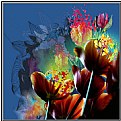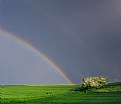
Adrian Grassi
(K=44) - Comment Date 5/4/2003
|
This is the image with auto level on ps.
|
|

|
|

Gene Provost
(K=147) - Comment Date 5/5/2003
|
Hello Adrian,
You should set your camera and Photoshop to use Adobe RGB. This gives you the widest gamut of colors.
At the default settings the D100 often gives results that seem underexposed. I believe this in intentional on the part of Nikon to ensure that you capture all the color information possible, particularly in the highlights. If you change the settings to give you an average brighter result, you will inevitibly blow out some highlights in some photos. Once that color information is lost, it's lost forever and cannot be regained with adjustments in Photoshop.
If your photo sessions will result in potential "keepers" I'd leave the settings at default and adjust in Photoshop to be sure you get the best results. If you just want to point-and-shoot, you can set up a second "bank" of settings to give a "better" out-of-the-camera result, but this may result in some overexposed highlights in some situations.
Good luck!
Gene
|
|
|
|

Marc Bessière
(K=27) - Comment Date 1/19/2004
|
Adrian,
I know this question is about 8 month old. But as a user of the great D100, I suggest the use of custom tone curves.
Go to the following link : http://fotogenetic.dearingfilm.com/custom_tone_curves.html you will get your answer. I'm using the "fotogenetic_provia_v32" and I'm really happy with it.
Regards.
--
Marc
|
|
|
|

Daniel Taylor
(K=3495) - Comment Date 1/20/2004
|
Beyond the answers already given, it is my experience that nearly every shot, digital or film scan, benefits from a levels adjustment. I often do it myself because I think auto in PS goes overboard and clips too much shadow/highlight detail. And on some types of photos it really has no clue what to do and just destroys the photo.
But I rarely see a shot that doesn't need levels tweaked. It's not necessarily a matter of wrong exposure (though in those cases levels is needed even more). Your first image doesn't look underexposed to me. It's more a matter of properly mapping the luminance values in your photo to the range that can be represented on a computer.
Also, I don't necessarily agree with the suggestion to use Adobe RGB. Yeah, it has a wider gamut, but photo ink jets are setup for sRGB. Unless you're going to spend the money to fully calibrate your monitor and printer, sRGB will probably give more pleasing results.
|
|
|
|

omer bakan
(K=2400) - Comment Date 2/3/2004
|
|
|
|
|

Adam E. J. Squier
(K=9803) - Comment Date 2/3/2004
|
There are lots of custom curves out there for the d100 -- it just depends on what you need. People have argued back and forth whether Nikon was right in making a conservative choice (but with more image processing later) or giving a better curve "right out of the box" at the expense of blowing out highlights more.
At least you are able to upload a custom curve to it to take care of the issue (not problem, issue). You can download a trial of Nikon Capture to control your camera (and upload the curve) for 30 days or so.
|
|
|
|

michaelle .
(K=3807) - Comment Date 2/3/2004
|
Adrian and Marc,
The Provia curve is awesome and a great recommendation, but I also like the wedding curve for when I need more latitude in the darks to lights without blowing highlights. It is a nice lower contrast, lower saturation curve that also works well for portraiture.
|
|
|
|
















